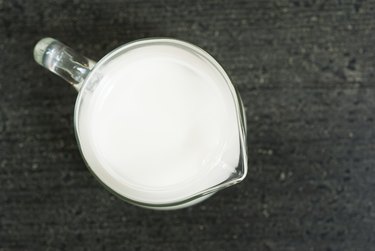
A well-rounded tummy tightening plan can give some added "oomph" to your health and fitness program. No, you can't wave a wand, and magically make that jiggly, loose fat disappear. However, you can take several concrete actions that set the stage for positive results.
View of Two Belly Fat Types
Video of the Day
All belly fat is not created equal. Subcutaneous fat, located just beneath your skin, is a somewhat innocuous substance that produces cellulite. This somewhat helpful fat also streamlines your glucose metabolism. Dangerous visceral fat is located beneath your abdominal muscle and around several vital organs. Through several systemic reactions, visceral fat can contribute to heart disease, Type 2 diabetes and sleep apnea.
Video of the Day
This harmful fat has also been linked to additional chronic medical conditions. In women, visceral fat has been connected to breast cancer and a higher incidence of gallbladder surgery.
There's also a demonstrated connection between dietary habits and visceral fat. An April 2017 study, published in the International Journal of Obesity, tracked the relationship between 2,218 subjects' eating habits and visceral fat. Researchers found that unhealthy eating habits strongly contributed to visceral fat development.
Tighten Post-Weight-Loss Belly Fat
You've recently dropped some weight, and congratulations are in order. You'd also like to banish that potentially harmful, loose fat around your belly. You know that core-strengthening exercises such as planks, Pilates and yoga can produce tummy tightening benefits.
However, these popular exercises won't make annoying belly fat disappear. To make progress on that front, adopt a two-pronged approach that includes a well-rounded food plan.
Next, actively target that belly fat with consistent aerobic workouts that elevate your heart rate. Resistance training is also beneficial. Engage in muscle-building exercises such as those practiced with high-intensity interval training (HIIT) that switches between high-energy activity periods and rest periods. As an added bonus, you can adapt your HIIT workout to gym equipment such as a rowing machine, elliptical or treadmill. Or, if you'd rather exercise in the great outdoors, turn your daily run into a beneficial HIIT session.
Finally, remember that a full-body, strength training regimen, which targets all your major muscle groups, will also help to rev up your metabolism and increase your whole-body fat burn.
Read more: How to Lose Weight in the Core
Get Benefits From This Abdominal Strengthening Exercise
Whether you're focused on toning and trimming a few specific spots, or you're firming up your body after childbirth, you're making great progress every day. However, you're still plagued by troublesome, loose fat that seems to have taken up permanent residence in your midsection. Fortunately, this simple breathing exercise will help to re-strengthen your abdominal muscles.
- Lie on a comfy, padded surface and bend your knees. Place a pillow under your head and shoulders.
- Let your body sink down into the surface, close your eyes and block out the world around you. Concentrate only on your breathing.
- Inhale deeply, noticing that your hands and abdomen are rising at the same time. Give your abdominal muscles a gentle outward stretch. Hold this position, and count to five.
- Gently exhale as your hands and abdomen lower. Then, contract your abdominal muscles. Again, count to five.
- Repeat this sequence three to five times. Avoid holding your breath.
Tighten Belly Fat after C-section
If you've recently experienced a C-section delivery, your body will take some time to recover from this major surgery. After at least six weeks have passed, and your physician has given you the thumbs-up for exercise, gradually ease into a gentle workout program. Walking and gentle stretching will get your body moving and your juices flowing. Practicing proper sitting posture will help to rebuild your stomach muscles.
When you're ready to begin working on that annoying belly fat, focus on strengthening your body's core muscles. Wall sits, pelvic tilts, full side planks and modified planks are all good bets. Keep conventional planks, sit-ups and crunches off the workout menu until your doctor approves these moves. Finally, work at your own pace, and pat yourself on the back with every small bit of progress.
Will Sit-ups Tighten Loose Belly Skin?
Sit-ups have long been touted as the go-to abdominal firming exercise. Fast forward to the present, however, and you'll notice that sit-ups have largely been replaced by popular plank exercises. This simple, core-strengthening, tummy-tightening pose requires you to hold a static position for a specific time period.
Planks have three distinct advantages over sit-ups. First, realize that sit-ups aren't good for your back, as they force your curved spine onto the hard floor. Sit-ups also press your hip flexors into service, potentially causing lower spine and lower back discomfort. And, you might be asking further, "Will sit-ups tighten loose belly skin?" The answer is most likely "no."
Plank exercises use muscles on the front, back and sides of your body, whereas sit-ups engage a scant few muscles. Finally, core-strengthening plank exercises more closely match other activities that require muscles to work in groups. Think sports, vigorous yard work and other activities that match your active lifestyle.
- The Heart Foundation: Healthy Living: "Belly Fat"
- Kaiser Permanente: Health & Wellness: "Belly Fat"
- Sutter Health: "Postpartum Exercises"
- Harvard Health Publishing: Healthbeat: "Want a Stronger Core? Skip the Sit-ups"
- Flo.health: "Exercises after Cesarean Delivery: What You Should and Shouldn't be Doing"
- National Institutes of Health: International Journal of Obesity: "Untangling the Relationship between Diet and Visceral Fat Mass through Blood Metabolomics and Gut Microbiome Profiling"
- Harvard Health Publishing: "Abdominal Fat and What to Do about It"